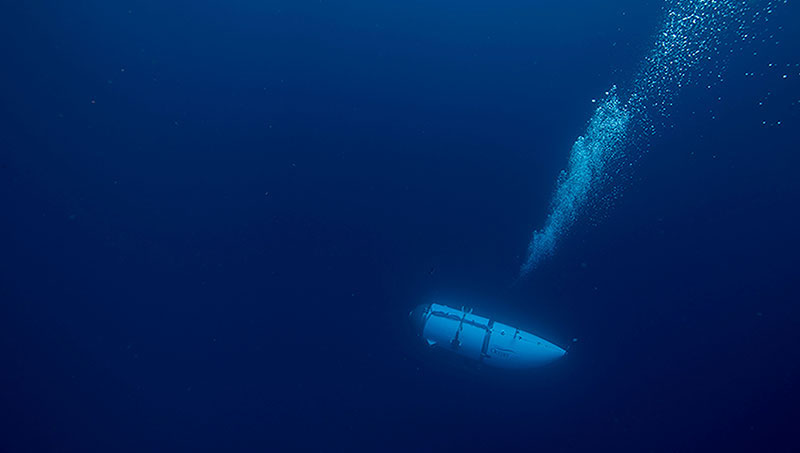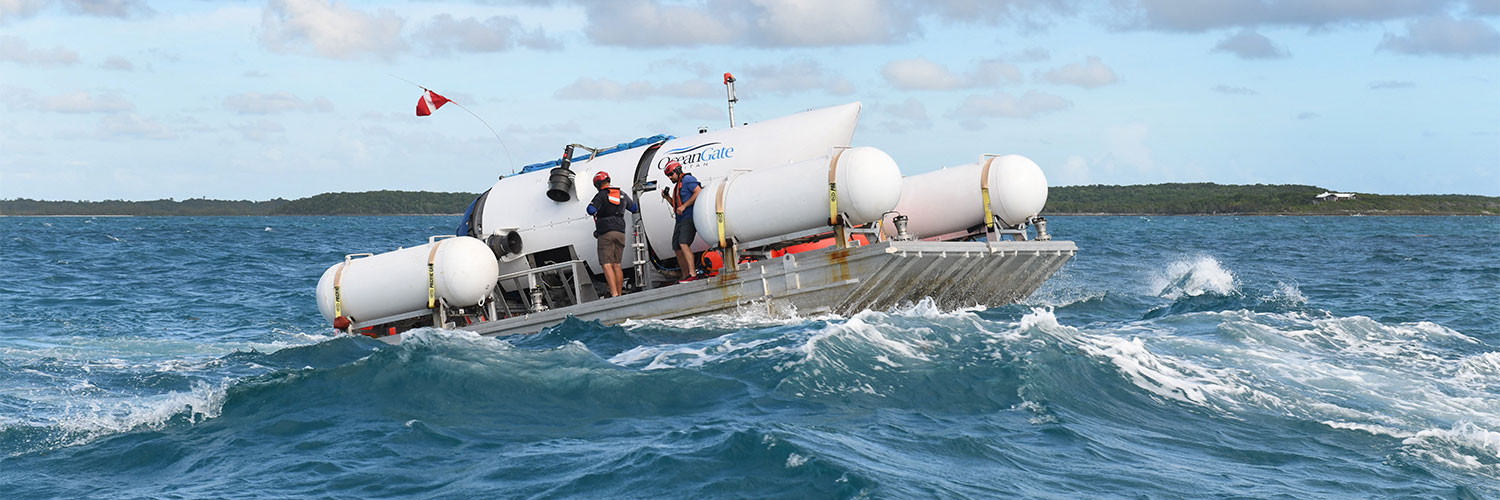
Editor's Note: The U.S. Coast Guard has confirmed that debris found near the Titanic's wreck are those of the lost Titan submersible, they said at a press conference on Thursday (June 22). All five men on board died when the Titan experienced a "catastrophic implosion." Read Live Science's coverage.
Periodic banging sounds detected at 30-minute intervals near the wreck of the Titanic may mean that the lost Titan submersible is intact with its crew alive inside, and it could even be recoverable, experts say.
A Canadian Boeing P-8 Poseidon reconnaissance plane detected the "underwater noises" using sonobuoys, the U.S. Coast Guard (USCG) Northeast announced early Wednesday (June 21). The banging was detected every 30 minutes, and the noises were still being heard 4 hours later.
Rescuers are scrambling to locate the source of the pulses. Until it's found, it's impossible to know if the noises are coming from the Titanic's wreckage, something else below the ocean, or the lost vessel, which has been missing since the morning of June 18 with five people onboard.
If the sounds are from the submersible, scientists say it rules out a number of possibilities as to how it disappeared and opens a narrow window for potential rescue.
Related: Missing Titanic submersible: Banging sounds heard in search for lost sub Titan
"If the sounds are coming from the submersible and the source is what we think it might be, the catastrophic scenario of a housing implosion didn't happen," said Blair Thornton, a professor of Marine Autonomy at the University of Southampton in the U.K.
If the submersible is found, Thornton said, a remotely-operated underwater vehicle (ROV) could bring it to the surface.
"I think locating it accurately is the biggest challenge. If you can locate it accurately and get submersibles to it, these ROVs are extremely capable platforms … they do a lot of manipulation tasks on targets that are not necessarily designed to be manipulated," Thornton told Live Science.
Lost in the abyss
The OceanGate Titan submersible went missing roughly 1 hour and 45 minutes into its 2.5-hour descent to the Titanic wreckage in a deep-sea trench in the North Atlantic Ocean. The sub now likely has less than 24 hours of its emergency oxygen supply remaining.
Before the periodic noises were detected, some scientists suggested that Titan had most likely imploded due to a fault in its carbon fiber and titanium hull, or in its viewpoint — whose manufacturer only certified as safe at depths of 4,265 feet (1,300 meters). The Titanic wreck sits about 12,500 feet (3,800 m) below the surface.
Frank Owen, a former commander of the Australian Navy and ex-director of its submarine escape and rescue project, told BBC News he was confident the noises were coming from within the Titan.
"If there was a 30-minute interval, it's very unlikely to be anything but human related," he said. “Onboard this craft is a retired French navy diver. He would know the protocol for trying to alert searching forces … on the hour and the half hour you bang like hell for three minutes.”
After being asked about the possibility that noises were made by human beings trapped inside a submersible deep below the Atlantic Ocean, John Mauger, a Rear Admiral in the US Coast Guard, told CBS News: "This is an incredibly complex site. You have to remember that it's the wreck site of the Titanic. There is a lot of metal and different objects in the water around the site."
"That's why it's so important that we've engaged experts from the navy that understand the science behind noise so they can classify or give us better information about what the source of that noise may be," he said.

Finding the Titan
The detection of the noises offers search and rescue teams some faint hope of finding the missing submersible, which could otherwise be lost among the Titanic's countless debris or carried miles from its initial diving site by powerful ocean currents.
"If a vehicle remains drifting in the water column, it could have drifted for several days by now, in which case we would expect it to be several tens of kilometres — or even further — away from the site," Thornton said. "So it does tell us that it's most likely stationary, and it could mean it's on the sea floor or or snagged on something."
Thornton said the single sonobuoy detection has probably already helped rescue teams narrow down the search area to 0.2 square miles (1 square kilometers) or so.
By deploying more sonobuoys (or arrays of underwater microphones called hydrophones) rescuers could use further noises to triangulate the sub's possible location to within 330 feet (100 m). ROV's tend to move at roughly human walking pace, so narrowing the search to a small area is essential.
"This starts to really become the range where a submersible at the right depth using active sonar can search a space like that," Thornton said.
Could there be a rescue?
If the Titan is found, attempting a rescue will be a significant challenge, and a record-breaking one at that. The deepest ocean rescue in history — the 1973 recovery of the Canadian submersible Pisces III and its two crew members off the coast of Ireland — took place at 1,575 feet (480 m) below the surface. That's eight times less than the greatest possible depth Titan could be resting at.
On Tuesday, a Deep Energy cable-laying vessel deployed an ROV in the search area, although whether it can descend all the way to the wreck is unclear. Other vessels with ROVs are currently en route. One of the most promising is the French research vessel L'Atalante, which has two ROVs capable of descending to the Titanic wreck's depth.
Ships and ROVs have successfully recovered vehicles from Titanic depths before, such as a U.S. fighter jet that was recovered from 12,400 feet (3,780m) below the South China Sea last year. An ROV wrapped the aircraft in a net and attached it to a hook connected to a ship on the surface, which winched it up.
Whether the Titan, if found, would need to be winched is also a matter of speculation — depending on whether the craft’s ballasts, which flood with water to fall and air to rise, remain intact.
"If it's snagged by something not too heavy, it may be possible for a remotely operated vehicle with manipulators (robot arms) to dislodge the obstruction. Then the submersible might be able to float to the surface if its weights can be jettisoned," Nicolai Roterman, a deep-sea ecologist and marine biologist at the University of Portsmouth in the U.K, told Live Science. "Another possibility would be trying to attach something buoyant to the submersible, but I'm not aware of that having been done at such depths before."
!["[T]he First and Fifth Amendments Require ICE to Provide Information About the Whereabouts of a Detained Person"](https://images.inkl.com/s3/publisher/cover/212/reason-cover.png?w=600)






